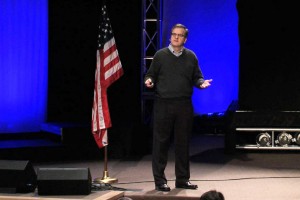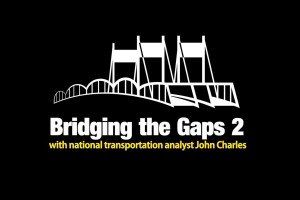For some time now Cascade Policy Institute president John Charles has monitored transit oriented development, something he claims has “became sort of a religious icon for Portland.”
Transit oriented development (TOD) is a mixed-use residential or commercial area designed to maximize access to public transport. Portland was an innovator in this, being the first region in the country to lobby the Federal Transit Administration for some of the federal pork barrel money flowing to a local transit project to subsidize high-density mix use development next to rail stations.
In his 30-minute presentation at Bridging the Gaps 2 last October, Charles delivered a scathing verdict on two showcase TODs, the Elmonica Station and the Beaverton Round.
Charles has a handle on the mentality of the TOD light rail adherents. For example, Charles says, proponents will “say seductively, oh we can’t sprawl … we can’t have low-density development at the fringe; we have to build up and not out because building up is so much cheaper.”
He pauses, then adds, “Yeah, except it is so much more expensive” to build multi-story structures. “In the whole Orwellian vocabulary in these discussions you have to understand that when they say cheaper they mean more expensive, when they say faster, they mean slower, when they say it’s good for you, it means bad for you. You have to cut through all of this.”
Charles’ interest in monitoring transit oriented developments began in the late 1990s after 1000 Friends of Oregon, a private nonprofit advocating intensive top down land use planning, opposed the proposed freeway expansions on the west side of Portland. In 1997 the group promoted a land use project called LUTRAQ (Land Use Transportation Air Quality Connections) that Charles says became a mania that morphed into a huge cult following.
The LUTRAQ plan used TOD principles to determine how to manage Oregon’s projected population growth in Washington County and support light rail and bus network extensions. Planners now had a road map to construct high-density projects using top down urbanist principles to reduce dependency on autos.
Skeptical about LUTRAQ’s utopian predictions, Charles set out to monitor the true travel and living patterns of TOD residents. He said it was “sort of like an anthropological project: It would be this new sort of breed of people, new culture of TOD dwellers.”
Verdict is in on transit oriented development, but no one is listening
The Elmonica Station transit oriented development in Washington County sits along a light rail line that runs through what once were empty cow pastures and wood lots. Initially, the Federal Transit Administration dismissed the Elmonica TOD proposal as being ludicrous and was not going to fund it. But according to Charles, then-Oregon Sen. Mark Hatfield met with top FTA officials and “crammed the money down their throats … his concession was that TriMet Metro … would use the powers of zoning to force every jurisdiction along the west side line to build these types of TODs.”
In 1998 – and a year behind schedule – the first train left Hillsboro. The LUTRAQ report predicted that if the planners’ suggestions were followed, by 2010 at Elmonica Station light rail would carry up to 28 percent of all peak morning trips.
In 2009, Charles decided to find out how well the planners’ predictions worked out.
Pointing to his PowerPoint slide, Charles says, “All these high-density projects at Elmonica station are kind of child-free zones. As to being car-free zone, cars are stacked everywhere.”
What about the projected 28 percent light rail ridership for the morning peak? Charles monitored several TODs within walking distance of the TriMet MAX light rail. “It doesn’t matter how close they (residents) are to the train, it doesn’t matter that it is easy to get there, it doesn’t matter if you made skinny streets, tiny yards, no yards, make it difficult to drive – in the morning when they get up” the residents drive. Only Elmonica station condominiums had a decent 10 percent light rail ridership with 70 percent auto use, he said, while with the other TOD projects light rail ridership was in the three percent range with around 90 percent auto use.
Zero learning at Beaverton Round
The Beaverton Round was built on a former sewage treatment facility. As Charles states with incredulity, “The goal was to convert it and give Beaverton the downtown that it never had. According to the Beaverton City Council and the planners, the Peter Calthorpe types, Beaverton residents suffered from some kind of identity crisis. That it is too spread out. It was auto-oriented. It had backyards and trees and that was alienating to them. So they needed some kind of dense center to pray to, or something.”
Early on Charles photographed the 5’ x 7’ architectural rendering hanging at the site announcing the Round, “Coming Soon, Right Here.” He asks, “What is the one thing you don’t see in this architectural rendering? Cars! See, this is the post car world, this is LUTRAQ, this is where we get 28 percent (ridership) – oh, excuse me, it wasn’t 28 percent, it was about three percent in reality … and we don’t need these stinking cars, because we have light rail and it is coming soon, right here.”
Two bankrupt developers and nearly a decade later, it turns out that building on a former sewage treatment plant poses expensive problems. Today, the residents that do live there drive cars, which was not in the original TOD plan. There is even a parking structure, the biggest single structure in the entire city of Beaverton.
Despite this, Metro still appropriated $4 million more to help tear down the nearby Westgate theater and expand, as Charles says sarcastically, because of the “success story of the Beaverton Round – because it was working so well.” However, when they needed yet another developer “to create Beaverton Round part 2, the son of the Round, no one was dumb enough to step up and do that.”
In his sardonic way Charles concludes, “There is zero learning going on here.”
Warning to Clark County, don’t be anesthetized by pretty pictures
Even though LUTRAQ has faded away it remains a sort of template for a brave new world underwritten by what Charles notes is “a whole stream of subsidies that … promotes crony capitalism where it’s a rigged market. It doesn’t reflect people’s preferences.”
Proponents still believe, “If we take away road building, if we put lots of money into light trail, if we use the power of zoning to make people live the way they don’t want to, that they won’t drive very much.”
Charles is not inherently opposed to trains but his “anthropological” studies clearly show light rail is a failed paradigm, and that TOD has failed. Yet the Transit oriented development mindset continues to drive policy in Portland to this day – Mayor Sam Adams has said regarding the Columbia River Crossing light rail project, “Look, if there is no light rail to Vancouver then there will be no other improvements.”
The way Charles sees it, this failed template may be coming to Clark County by way of the CRC project, complete with “goofy hearings” with their safe-looking utopian plans and “anesthetizing” depictions of light rail stations on Hayden Island and Vancouver.
Charles is blunt about the purpose of the CRC project. “Light rail drives everything. The CRC is, in my mind, a light rail project, and oh by the way with a highway and some interchange improvements thrown in for political cover but it is fundamentally a light rail project.”
The federal government is expected to contribute more than $1 billion in federal highway and transit funds for the CRC project, the major chunk of which is a subsidy for the light rail.
And what drives light rail development? Charles says the pitch has changed. “Most light rail advocates don’t actually defend light rail anymore as a people mover because … even in theory it can’t move very many people, so now its justified as ‘oh it’s a catalyst for TOD’.”
Just in case anyone dismisses the significance of this, he warns that “Any conversation that is being had in Vancouver about light rail needs to be a conversation about people-moving abilities – not whether it is a catalyst for development.”
In John Charles’ experience, light rail fails to move more than a small proportion of the population.











